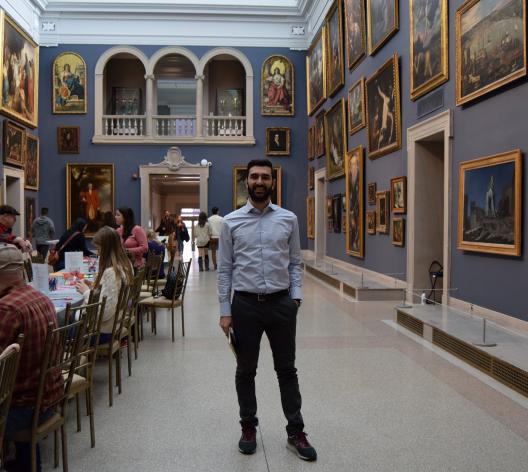
Alessandro Serrani, prix Marc de Montalembert 2024
Description du projet
Arrivé dans la Marca d’Ancône, le peintre vénitien Carlo Crivelli choisi d’abord la ville de Fermo, puis celle d’Ascoli Piceno, comme des centres de travail et de diffusion de son art. Autour de 1470, il entame un processus d’échanges avec le contexte artistique hétérogène des Marches, qui était caractérisé par une persistance des traits stylistiques du gothique tardif.
La présente recherche se propose d’examiner les polyptyques et les retables de Crivelli exécutés dans la région des Marches, en se concentrant en particulier sur ceux qui ont été réalisés pour la côte adriatique et qui nous sont parvenus sans leur charpente en bois d’origine. L’objectif de ce projet est de fournir des reconstructions fiables des ces polyptyques, dont nous possédons souvent les panneaux sans toutefois connaître leur disposition à l’intérieur de charpentes. L’étude globale de ces œuvres permettra également d’enrichir et de préciser nos connaissances sur les techniques d’assemblage de la charpenterie adriatique au XVe siècle. En effet, Carlo Crivelli se distingue comme un protagoniste dans ce domaine, en adaptant les formes traditionnelles des autels à ses besoins de représentation.

Biographie
Diplômé d’une licence en littérature moderne à l’Université de Macerata, Alessandro Serrani poursuit ses études à l’Université de Bologne où il termine un master en arts visuels en mars 2019. Son mémoire de recherche a été dédié à la chapelle Vaselli de la basilique San Petronio de Bologne et a été dirigé par le professeur Daniele Benati. Il termine actuellement son programme de doctorat en arts visuels, arts du spectacle et arts médiatiques à l’Université de Bologne (XXXVIe cycle, directeur de thèse : professeur Daniele Benati). Le titre de sa thèse est le suivant: “Travail et art. Les corporations professionnelles à la Renaissance bolonaise”. Dans le cadre de son doctorat à l’Université de Bologne, M. Serrani a effectué une période d’étude au Boston College en tant que chercheur invité. M. Serrani a reçu des bourses de la Fondazione di Studi di Storia dell’Arte Roberto Longhi à Florence et de la Fondazione Giorgio Cini à Venise. Il est intervenu lors de conférences nationales et internationales telles que la journée d’étude sur le polyptyque de Griffoni (Bologne, 2020) et la conférence annuelle de la Renaissance Society of America (Dublin, 2022). Il a publié des articles scientifiques dans des revues telles que “Paragone”, “Studi di storia dell’Arte” et “Saggi e memorie di storia dell’Arte”.
M. Serrani travaille principalement sur la peinture du XVe siècle en Italie centrale et septentrionale, avec une spécialisation dans la reconstruction de polyptyques et de retables. Un autre domaine privilégié de ses recherches est l’art du bois, la charpenterie et l’intarsia.
Project Description
Once arrived in the Marca of Ancona, Carlo Crivelli first identified the city of Fermo and then that of Ascoli Piceno as poles from which to spread his art. From the end of the seventh decade of the 15th century, he began a very prolific process of interchange with Marche’s heterogeneous artistic context, characterized by a highly fascinating persistence of late Gothic stylistic traits.
The present research wants to examine Crivelli’s polyptychs and altarpieces executed in the Marche region, focusing especially on those made for the Adriatic coast and which have reached us without their original wooden carpentry. The aim of this project is to provide reliable reconstructions of Crivellesque polyptychs of the Marche coast, of which we often have the panels without, however, knowing how they were arranged in their carpentry. An overall study of them will also provide enrichment and specification of our knowledge about the assembly techniques of Adriatic carpentry in the 15th century. Indeed, Carlo Crivelli stands out as a protagonist also in this field, often bending traditional altar forms to his representational needs.

Biography
Having graduated from the University of Macerata in 2016 with a degree in Modern Literature, under the supervision of Professor Graziano Alfredo Vergani, in March 2019, Alessandro Serrani obtained a Master’s in Visual Arts from the University of Bologna. His thesis on the Vaselli Chapel of Bologna’s Basilica of San Petronio was supervised by Professor Daniele Benati. He is currently completing his PhD program in Visual, Performing and Media Arts at the University of Bologna (XXXVI cycle, supervisor: Professor Daniele Benati). His research project title is: “Work and Art. Trade guilds in the Bolognese Renaissance”. As part of his PhD at the University of Bologna, Dr. Serrani conducted a period of study at Boston College as visiting researcher. Dr. Serrani has been awarded scholarships from the Fondazione di Studi di Storia dell’Arte Roberto Longhi in Florence and the Fondazione Giorgio Cini in Venice. He was a speaker at national and international conferences such as the Griffoni Polyptych Study Day held in 2020 in Bologna and the 2022 RSA Annual Conference in Dublin. He published scientific articles in magazines such as “Paragone”, “Studi di storia dell’Arte” and “Saggi e memorie di storia dell’Arte”.
Dr. Serrani mainly works on 15th-century painting in central and northern Italy, with a specialization in polyptych and altarpiece reconstruction. Another privileged field of his research is the wood art, carpentry and intarsia.
